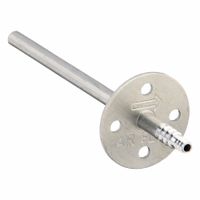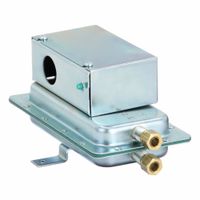Call +(254) 703 030 000 / 751 483 999 / 721 704 777
- Home
- Hvac And Refrigeration
- Hvac Controls And Thermostats
- Hvac Sensors Switches
- Air Pressure Sensors Switches
.....Read More
Frequently Asked Questions
What is the purpose of air pressure sensors in an HVAC system?
Air pressure sensors in an HVAC system serve several critical functions:
1. **System Efficiency**: They monitor the pressure levels within the system to ensure optimal performance. By maintaining the correct pressure, the system can operate efficiently, reducing energy consumption and operational costs.
2. **Safety**: Pressure sensors help prevent dangerous conditions by detecting abnormal pressure levels that could lead to equipment failure or hazardous situations. They trigger alarms or shut down the system if pressures exceed safe limits.
3. **Airflow Management**: These sensors ensure proper airflow by monitoring the pressure differential across filters, ducts, and other components. This helps in maintaining consistent air distribution and comfort levels throughout the building.
4. **Filter Monitoring**: By measuring the pressure drop across air filters, sensors can indicate when filters are clogged and need replacement, ensuring air quality and system efficiency.
5. **System Diagnostics**: Pressure sensors provide data for diagnosing system issues. Abnormal pressure readings can indicate problems such as leaks, blockages, or malfunctioning components, allowing for timely maintenance and repairs.
6. **Control and Automation**: They are integral to the automated control systems in modern HVAC setups, enabling precise adjustments to maintain desired environmental conditions.
7. **Compliance and Standards**: Pressure sensors help ensure that HVAC systems comply with industry standards and regulations regarding safety, efficiency, and environmental impact.
Overall, air pressure sensors are vital for the reliable, efficient, and safe operation of HVAC systems, contributing to energy savings, system longevity, and occupant comfort.
How do differential air pressure sensors work?
Differential air pressure sensors measure the difference in pressure between two points. They consist of a sensing element, typically a diaphragm, that deflects when exposed to pressure differences. This diaphragm is often made of materials like silicon or metal, which are sensitive to pressure changes.
The sensor has two ports: one for the high-pressure side and one for the low-pressure side. When there is a pressure difference between these two ports, the diaphragm deflects. This deflection is converted into an electrical signal, usually through piezoresistive, capacitive, or inductive methods.
In piezoresistive sensors, the diaphragm's deflection changes the resistance of a piezoresistive material, altering the electrical current flowing through it. This change is proportional to the pressure difference. Capacitive sensors measure changes in capacitance caused by diaphragm movement, while inductive sensors detect changes in inductance.
The electrical signal is then processed and amplified to provide a readable output, often in volts or milliamps, which corresponds to the pressure difference. This output can be used for monitoring and control in various applications, such as HVAC systems, medical devices, and industrial processes.
Differential pressure sensors are valued for their accuracy, sensitivity, and ability to measure small pressure differences. They are essential in applications where maintaining specific pressure conditions is critical, such as in clean rooms or fluid flow systems.
What are the common applications of air pressure sensing switches in HVAC systems?
Air pressure sensing switches are crucial components in HVAC systems, serving several key applications:
1. **Filter Monitoring**: They detect pressure drops across air filters, indicating when a filter is clogged and needs replacement. This ensures efficient airflow and maintains indoor air quality.
2. **Fan Control**: These switches monitor the operation of fans by sensing the pressure difference across them. They ensure that fans are functioning correctly, preventing overheating and ensuring proper ventilation.
3. **Duct Pressure Monitoring**: They help maintain optimal pressure within ductwork, ensuring balanced airflow throughout the system. This prevents issues like duct leakage or collapse.
4. **Combustion Air Proving**: In systems with combustion processes, air pressure switches verify the presence of adequate combustion air, ensuring safe and efficient operation of burners and preventing dangerous conditions like backdrafting.
5. **Variable Air Volume (VAV) Systems**: They regulate the pressure in VAV systems, adjusting the airflow to different zones based on demand, enhancing energy efficiency and comfort.
6. **Heat Exchanger Protection**: By monitoring pressure differences, these switches protect heat exchangers from conditions like freezing or overheating, which can lead to system failure.
7. **Safety Interlocks**: They act as safety devices, shutting down the system if abnormal pressure conditions are detected, preventing damage to the system and ensuring user safety.
8. **Boiler and Furnace Operation**: In boilers and furnaces, they ensure that the draft is adequate for safe operation, preventing the buildup of harmful gases.
9. **Airflow Verification**: They confirm that there is sufficient airflow in the system, which is critical for the efficient operation of components like coils and heat exchangers.
These applications highlight the importance of air pressure sensing switches in maintaining the safety, efficiency, and reliability of HVAC systems.
How do you install an air pressure sensing probe in an HVAC duct?
1. **Select Location**: Choose a straight section of the duct, away from bends, dampers, or other obstructions, to ensure accurate readings.
2. **Gather Tools and Materials**: You will need a drill, drill bits, screwdriver, wrench, air pressure sensing probe, mounting hardware, and sealant.
3. **Turn Off HVAC System**: Ensure the HVAC system is turned off to prevent air flow during installation.
4. **Mark the Spot**: Use a marker to indicate where the probe will be installed on the duct.
5. **Drill Hole**: Drill a hole in the duct at the marked spot. The hole should be slightly larger than the diameter of the probe to allow for easy insertion.
6. **Insert Probe**: Carefully insert the probe into the hole. Ensure the sensing element is fully inside the duct for accurate measurement.
7. **Secure Probe**: Use the provided mounting hardware to secure the probe to the duct. This may involve screws or clamps, depending on the probe design.
8. **Seal the Installation**: Apply sealant around the probe where it meets the duct to prevent air leaks.
9. **Connect Wiring**: If the probe is electronic, connect the wiring according to the manufacturer's instructions. Ensure connections are secure and insulated.
10. **Test Installation**: Turn the HVAC system back on and check the probe for proper operation. Verify that there are no air leaks and that the probe is providing accurate readings.
11. **Calibration**: If necessary, calibrate the probe according to the manufacturer's guidelines to ensure accurate pressure readings.
12. **Document Installation**: Record the installation details, including the location and any calibration settings, for future reference.
What are the signs of a faulty air pressure sensor in an HVAC system?
1. **Inconsistent Airflow**: Fluctuating or uneven airflow from vents can indicate a faulty sensor, as it may not be accurately reading pressure levels.
2. **System Short Cycling**: The HVAC system may turn on and off more frequently than normal, as the sensor fails to provide correct pressure readings, causing the system to misinterpret the need for heating or cooling.
3. **Increased Energy Bills**: A malfunctioning sensor can lead to inefficient system operation, resulting in higher energy consumption and increased utility costs.
4. **Poor Temperature Regulation**: Inaccurate pressure readings can cause the system to struggle in maintaining the desired temperature, leading to discomfort.
5. **Error Codes**: Modern HVAC systems may display error codes or alerts on the thermostat or control panel, indicating sensor issues.
6. **Unusual Noises**: Strange sounds, such as hissing or banging, may occur if the system is compensating for incorrect pressure readings.
7. **System Failure to Start**: The HVAC system might not start at all if the sensor is unable to detect the necessary pressure levels to initiate operation.
8. **Frequent Filter Changes**: If the sensor is not functioning properly, it may not signal when filters need changing, leading to more frequent replacements.
9. **Visible Damage**: Physical inspection may reveal damage or wear on the sensor, such as corrosion or broken components.
10. **Increased Humidity Levels**: A faulty sensor can affect the system's ability to control humidity, leading to higher indoor moisture levels.
11. **Professional Diagnosis**: Technicians may use diagnostic tools to confirm sensor issues, as they can mimic other HVAC problems.
How do you calibrate an air pressure sensor or switch?
1. **Gather Equipment**: Obtain a calibrated pressure source, a multimeter, and the manufacturer's calibration instructions.
2. **Safety Precautions**: Ensure the system is depressurized and power is disconnected before starting.
3. **Connect Equipment**: Attach the pressure source to the sensor or switch. Connect the multimeter to the sensor's output terminals.
4. **Zero Calibration**: Apply zero pressure. Adjust the zero setting on the sensor until the multimeter reads the expected output (e.g., 4 mA for a 4-20 mA sensor).
5. **Span Calibration**: Apply full-scale pressure. Adjust the span setting until the multimeter reads the full-scale output (e.g., 20 mA for a 4-20 mA sensor).
6. **Intermediate Checks**: Apply known intermediate pressures and verify the output matches expected values. Adjust linearity if necessary.
7. **Switch Calibration**: For pressure switches, apply pressure until the switch activates. Adjust the setpoint screw to the desired activation pressure. Repeat for deactivation pressure if applicable.
8. **Recheck Zero and Span**: Reapply zero and full-scale pressures to ensure settings remain accurate.
9. **Document Results**: Record calibration data, including date, technician, and any adjustments made.
10. **Reassemble and Test**: Reconnect the sensor to the system, restore power, and verify proper operation under normal conditions.
What are the differences between air pressure sensors and air pressure switches?
Air pressure sensors and air pressure switches are both devices used to monitor and respond to changes in air pressure, but they serve different functions and have distinct characteristics.
Air Pressure Sensors:
1. **Functionality**: Air pressure sensors measure the actual pressure of air or gas in a system and provide continuous, real-time data. They convert pressure into an electrical signal that can be read by a control system.
2. **Output**: They provide a variable output, often in the form of an analog signal (e.g., 4-20 mA, 0-10 V) or digital output (e.g., I2C, SPI).
3. **Applications**: Used in applications requiring precise pressure monitoring, such as HVAC systems, automotive, industrial automation, and weather stations.
4. **Complexity**: Typically more complex, with the ability to interface with other systems for data logging, analysis, and control.
5. **Cost**: Generally more expensive due to their precision and complexity.
Air Pressure Switches:
1. **Functionality**: Air pressure switches are designed to open or close an electrical contact when a certain pressure threshold is reached. They act as a binary device, either on or off.
2. **Output**: They provide a discrete output, usually in the form of a simple on/off switch.
3. **Applications**: Commonly used in safety and control applications where a simple response to pressure changes is needed, such as in compressors, pumps, and safety systems.
4. **Complexity**: Simpler in design, focusing on reliability and durability rather than precision.
5. **Cost**: Typically less expensive due to their straightforward functionality.
In summary, air pressure sensors are used for detailed monitoring and data collection, while air pressure switches are used for basic control and safety functions.


